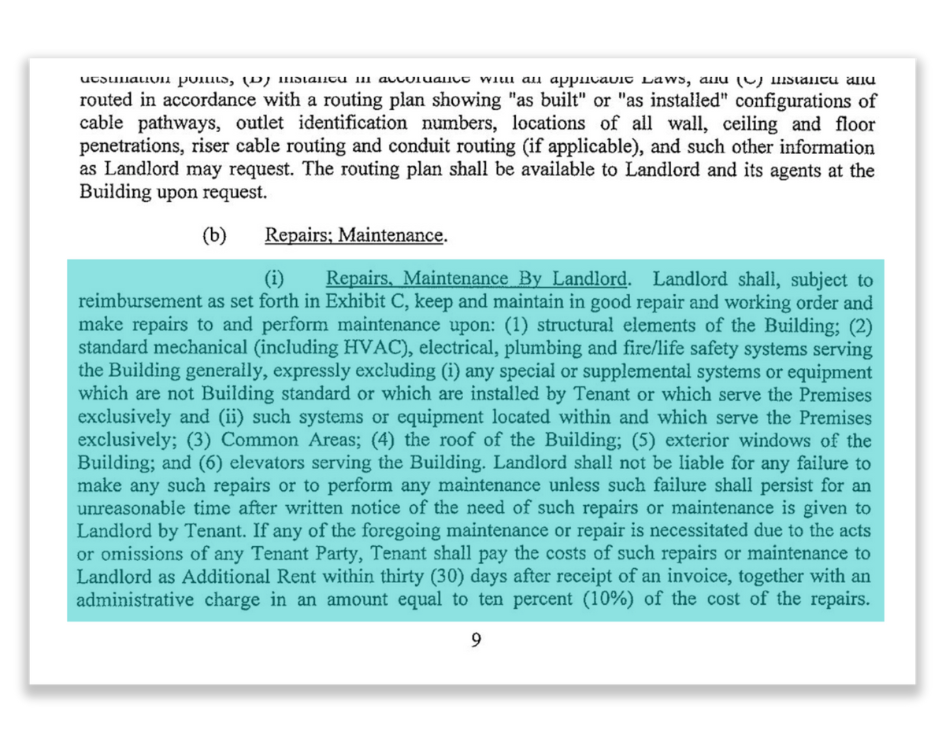Modified Gross Leases: A Flexible and Efficient Solution for Commercial Real Estate
Not to be overlooked, the commercial lease is a treasure trove of insight. With this post, we'll examine one commercial lease in particular, the modified gross; its common applications, landlord and tenant benefits, and flexibilities and efficiencies it has to offer.

In commercial real estate transactions, leases are a critical document for every party involved in due diligence, leasing, financing, and beyond. Among the various lease structures available, every single one disperses responsibilities among all parties and it can be a powerful referential tool for future negotiations and, by extension, a means to manage the relationship between landlord and tenant.
Today, as vacancy trends continue to eb and flow, flexible leases are becoming increasingly attractive to tenants and a powerful negotiation tool for landlords looking to fill buildings. Modified gross leases are a great example of a lease with equity options in which both parties can take on some of the financial responsibilities of the property making crucial tasks like financial planning and building operations a little bit easier to manage.
Jump To A Section in This ArticleWhat Is a Modified Gross Lease?
Modified Gross Lease Example
Tenant & Landlord Benefits of MGs
MG Vs NNN
Full Service Gross Vs Modified Gross
Properties That Commonly Used MGs, NNN, or Full Service Gross
Navigating Complex Lease Terms With AI
What Is a Modified Gross Lease?
A modified gross lease is a lease structure in commercial real estate that combines elements of both gross and net leases. While this arrangement can offer some expense allocation flexibility and balance, the tenant often assumes responsibility for specific expenses, while the landlord covers others. This sharing of costs is typically determined through negotiations and can vary based on the specific needs and preferences of both parties.
Unlike a traditional gross lease where the landlord bears all operating expenses, a modified gross lease allows for a fair distribution of financial obligations. The tenant is usually responsible for utilities, janitorial services, and interior maintenance, while the landlord covers major structural expenses like repairs and property taxes. This shared approach provides a level of predictability for both parties, allowing tenants to budget for their occupancy costs while enabling landlords to effectively manage their overall expenses.
The beauty of a modified gross lease lies in its flexibility. It allows for customization and tailoring to meet the unique requirements of each tenant and property. By negotiating the allocation of expenses, tenants can have greater control over the specific costs they are responsible for, aligning the lease structure with their operational needs. Landlords, in turn, benefit from reduced financial risk and the potential for more stable and long-term tenant relationships.
In essence, a modified gross lease embodies a collaborative approach to commercial real estate leasing, where both parties can find common ground and create an arrangement that suits their individual needs and fosters a mutually beneficial relationship.

Common Uses, Plus a Modified Gross Lease Example
Modified gross leases are common in buildings with multiple tenants, for instance in an office building. So how does this arrangement translate into the actual finances? Let’s say, hypothetically, that the building has one electrical meter and that the electrical bill is $1000 a month. If there are 5 tenants in the building, in a modified gross lease each tenant would be responsible for paying $200. This is an example of the division of operating costs under a modified gross lease.
Another possible arrangement under a modified gross lease could require the tenants to pay a percentage of the electrical bill based on the square footage of their space. So tenants with a large share of the building’s square footage would be required to pay slightly more on their utilities.
The Benefits of Modified Gross Leases
Modified gross leases offer several advantages that make them an attractive option for both landlords and tenants. From cash flow to risk management, it can be a smart option for tenants and landlords who need clarity and predictability around financial planning and building operations.
Tenant benefits of a modified gross lease
Flexibility: Unlike traditional gross leases, which require the landlord to cover all operating expenses, modified gross leases allocate specific costs between the two parties. This arrangement allows for greater flexibility and a more equitable expense sharing.
Predictability: Modified gross leases also offer tenants predictability. With a clear understanding of their financial obligations, tenants can effectively budget for their occupancy costs, as they are aware of the specific expenses they are responsible for.
Financial planning: Additionally, this predictability allows for better financial planning while helping to reduce the risk of unexpected financial burdens for the tenant. This ultimately helps simplify financial planning, giving tenants greater control of their expenses.
Landlord benefits of a modified gross lease
Increased cash flow: For landlords, modified gross leases offer increased cash flow stability. By shifting some expenses to the tenant, landlords can better manage and control operating costs.
Risk mitigation: In addition to better cash flow, a modified gross lease arrangement can help reduce the risk of unforeseen expenses, providing a more predictable income stream, and simplifying financial planning.
Modified Gross Leases vs. NNN Leases
Modified gross leases are often compared to NNN (triple net) leases, as they both involve shared expense responsibilities. However, there are distinct differences between the two lease structures.
In NNN leases, the tenant is responsible for all property expenses, including property taxes, insurance, and maintenance costs. Landlords receive a net lease amount, as they are relieved of the burden of operating expenses. On the other hand, modified gross leases allocate specific expenses between the landlord and tenant, typically with the landlord covering major structural expenses like roof repairs and the tenant responsible for utilities and interior maintenance.
The key advantage of modified gross leases over NNN leases is that tenants are not burdened with the full financial responsibility for property expenses. While NNN leases offer simplicity for landlords, modified gross leases strike a fairer balance between the two parties, sharing costs based on usage and necessity.
Full Service Gross Vs Modified Gross
Another common lease structure is the full-service gross lease. In a full-service gross lease, the landlord assumes all operating expenses, including utilities, maintenance, and janitorial services. This type of lease simplifies the tenant's financial obligations, but it comes with a higher base rent to cover these additional expenses.
Modified gross leases differ from full-service gross leases by requiring tenants to bear certain expenses directly. While both lease structures provide a level of convenience for tenants, modified gross leases allow for greater customization and tailoring to specific tenant needs.
Flexibility really is one of the greatest advantages when comparing modified gross vs full-service gross leases. Tenants can negotiate and modify the lease terms to align with their specific operational requirements, potentially reducing unnecessary costs. Additionally, the transparency and control over expenses that modified gross leases offer can be appealing to tenants who want a more hands-on approach to their occupancy costs.
Modified gross leases present an attractive alternative to traditional lease structures in commercial real estate. By allocating expenses between landlords and tenants, these leases offer a fair and flexible solution that benefits both parties. Tenants enjoy cost predictability, better financial planning, and the ability to customize lease terms to fit their needs. Landlords benefit from increased cash flow stability, reduced operating risks, and the potential for more favorable long-term tenant relationships—which can be a godsend in unpredictable markets.
Which Properties Use Full Service, NNN, and Modified Gross Leases?
As we’ve mentioned, modified gross leases are a relatively common arrangement in CRE. But the financial benefits are more applicable to certain types of buildings than others. For instance, it might be more advisable for tenants in a multi-tenant building, like a shopping center or an office building, to enter into a modified gross lease vs NNN and share financial responsibilities around utilities and operations.
On the other hand, it’s common for free-standing buildings owned by financial institutions, industrial parks, or office buildings with a single tenant to use a NNN. NNN leases can feel a bit financially dubious because the tenant is on the hook for so many contingencies. However, NNN leases tend to have lower base rent and therefore can actually be a more financially prudent option than full-service gross.
Full service gross leases in which the landlord pays for all building expenses might seem like the more white-glove option of the three. But, in fact, full service gross leases actually allow landlords to charge exorbitantly more for base rent than the other two commercial lease options described above. Thus, one typically finds a full service gross lease in Class A properties including office buildings, hotels, restaurants, or boutique small businesses in top tier real estate markets.
Navigating the Most Complex Lease Terms
Leases come in all different shapes, sizes and states of disrepair but they all hold critical information for CRE professionals. From mitigating potential risks to working through negotiation periods with tenants, it’s important for all of that lease data—whether it comes from a NNN or modified gross—to live in an accessible place in an accessible form.
Abstracting tough leases is kind of what we do—actually, we’ve been doing it since about 2018. Our AI model and CRE experts can make magic out of the most mundane or the most chaotic lease documentation, transforming script (or sometimes handwritten scrawl) into a quantifiable data point (like a commencement date) that brings profound context to asset managers, property managers, brokers, leasing professionals and more for accomplishing daily tasks and the future performance of the portfolio.
Let us help you abstract your first lease. Request a demo or reach out to our team with a question about Prophia’s automation capabilities.
Hannah Overhiser
Hannah is Prophia's Content Marketing Manager and a seasoned B2B and B2C marketer. Her career began in eCommerce consulting with a focus on code testing. This technical expertise transferred seamlessly to SEO and she started working agency-side as an SEO and Content Strategist. Today, her home is Prophia, and she puts...

